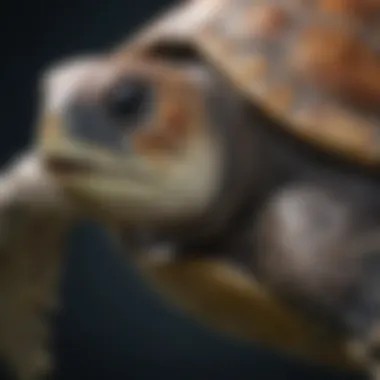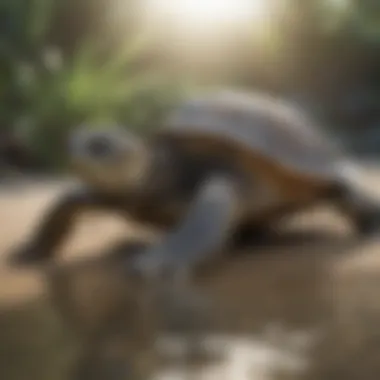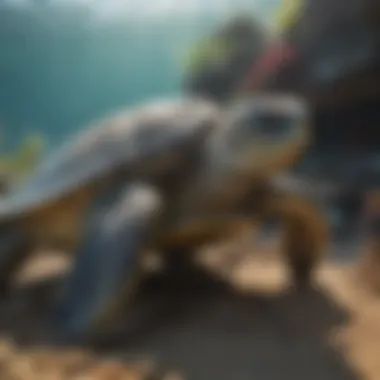Understanding Sea Turtles: Classification and Ecology Insights


Nature Topic Overview
Sea turtles are fascinating creatures that play a far more significant role in the ocean ecosystem than many understand. This article aims to clarify their classification, emphasizing that these majestic creatures are reptiles, not invertebrates, as commonly misunderstood. Through careful exploration of their anatomy, evolution, and habitat, we intend to present an insightful view on these marine reptiles.
Understanding sea turtles gets to the heart of why categorization in the animal kingdom matters. Their existence links to various marine species, demonstrating their ecological importance. By shedding light on these classification challenges, this article will inform readers while sparking a sense of curiosity about the sea turtles' world.
Fun Facts and Trivia
Here are some interesting facts about sea turtles:
- Sea turtles have been around for more than 110 million years!
- They can hold their breath for up to five hours while resting.
- Some species of sea turtles can weigh as much as 2,000 pounds!
These surprising facts highlight the incredible nature of sea turtles and attract interest from young readers. Visual illustrations can further enhance this learning experience.
Wildlife Explorations
There are seven species of sea turtles, each with unique characteristics. These include:
- Leatherback: The largest turtle species, good at diving.
- Green turtle: Known for its weight and large size.
- Hawksbill: Distinguished by its colorful shell.
Each sea turtle species has its habits and habitat preferences, often found in coastal beaches and oceanic regions. Exploring these biological details enriches children’s understanding of biodiversity.
Facts about animals in the specific habitats are equally important. For example, many sea turtles nest on beaches that are also homes to various other wildlife, like seagulls. This interplay of species interests them as they observe different interactions between creatures of the ocean.
Environmental Awareness
Conservation is critical to the survival of sea turtles. Human activity greatly affect the environments these turtles thrive in. More awareness around issues that threaten their existence—like plastic pollution and poaching—will enhance sustainability efforts.
Children can participate in conservation by taking small steps, such as:
- Reducing plastic use to help keep oceans clean.
- Learning about local wildlife and ecosystems.
- Understanding the importance of protecting nesting sites.
DIY Nature Activities
Kids can learn about sea turtles and their environment through hands-on activities. Here are some suggestions:
- Craft a Sea Turtle Mask: Using cardboard or paper plates, children can mimic their favorite sea turtle.
- Shell Collecting: During beach trips, kids can gather shells and learn about the marine animal that housed it.
- Nature Walks: Exploring local habitats fosters an appreciation for nature.
These activities not only provide fun experiences but also instill the values of curiosity and respect for nature.
Understanding sea turtles is more than just a lesson in classification; it’s about being part of a bigger eco-narrative that even children can contribute to.
The classification of sea turtles opens doors to admire their beauty and wonder while driving home the vital message of conservation.
Prelims to Sea Turtles
Understanding sea turtles is essential for both environmental stewardship and knowledge about wildlife biology. These creatures play significant roles in the marine ecosystems, yet many still confuse their classification. This confusion can lead to the misconception that they are invertebrates. This section will clarify what sea turtles are, define invertebrates, and highlight common myths surrounding sea turtles.
What are Sea Turtles?
Sea turtles are marine reptiles recognized for their unique physical characteristics and adaptations. Unlike many other turtles, sea turtles spend their entire lives in the ocean. They belong to an ancient group of reptiles that first appeared around 110 million years ago. This long history makes them fascinating subjects of study.
There are seven known species of sea turtles, including the loggerhead, green turtle, and hawksbill. These turtles are distinguished from one another by their sizes, shell shapes, and feeding behaviors, such as the green turtle's preference for seagrass. They play crucial roles in maintaining healthy marine habitats by contributing to the balance of sea grass ecosystems and coral reefs, underscoring their ecological importance.
Definition of Invertebrates
Invertebrates are animals that lack a backbone or vertebral column. Seas turtles do not fit into this classification as they are vertebrates, characterized by having a skeleton. Examples of invertebrates include jellyfish, octopuses, and various shellfish. Understanding this distinction is fundamental because classifying sea turtles accurately is important. Their vertebrate classification allows us to study not only their physiology but also their evolutionary adaptations over millions of years.


Common Misconceptions
Many people mistakenly categorize sea turtles as invertebrates due to their aquatic lifestyle and gentle appearance. This error may arise from the alternative view that relates aquatic creatures primarily to invertebrates. Additionally, some assume that since turtles are often thought of as “slow” animals, they resemble organs or creatures unaffected by or lacking a spine. Let’s clear this up:
- Sea turtles are not fish nor invertebrates; they are reptiles.
- They possess bony shells formed from the ribs, protecting their vertebrate bodies.
- Their slow movements can be deceptive; they are mechanism of surviving in their environment rather than indicating lack of complexity.
Recognizing these key points not only sheds light on the classification of these reptiles but also paves way for understanding their behaviors and ecological impacts.
Biological Classification
Biological classification is crucial in understanding the rich diversity and evolution of life forms, including sea turtles. This section provides insight into how organisms are categorized based on shared characteristics. This classification helps us appreciate sea turtles' roles in the ecosystem and their relationships with other species.
The Phylum Chordata
Sea turtles belong to the phylum Chordata, which comprises animals possessing a notochord, a dorsal nerve cord, and pharyngeal slits during some developmental stage. These features are essential for identifying the basic anatomical structure shared by chordates. Within this phylum, sea turtles share distinct characteristics with other reptiles.
This classification helps young readers explore the aspects that unite different forms of life under Chordata. Also, understanding this category establishes a foundational knowledge in scientific study.
Characteristics of Reptiles
Reptiles offer specifics that help distinguish them from other animal classes. Key characteristics of reptiles include their scaly skin, which aids in water retention—an essential factor for survival in a variety of climates. They are also cold-blooded, regulating their body temperature through their surroundings. Unlike amphibians, reptiles lay eggs with harder shells, providing better protection to the developing young.
By highlighting these features, readers gain a better understanding of the unique lifeforms that belong to the reptile class and appreciate how they endure in varied ecosystems.
Classification of Sea Turtles
Family and Species
Sea turtles are classified into families such as Cheloniidae and Dermochelyidae. Understanding families and species offers a deeper insight into the behavior and ecology of specific types of sea turtles. Each family comprises different species that adapt distinctly to their environments. For instance, the Loggerhead turtle belongs to the Cheloniidae family and is prevalent in many oceans worldwide.
The key characteristic of these turtles is their resilient nature in – when faced with environmental changes. Focusing on the unique attributes of families improves appreciation of their adaptability and survival strategies.
Identification Traits
Identification traits highlight features that categorize sea turtles in different species. Common traits include body size, shell shape, and coloration. For example, the Leatherback turtle can easily be distinguished from other species due to its large size and leathery shell. Identification traits assist in recognizing these majestic creatures in both educational contexts and conservation efforts.
Understanding these traits can aid young readers as they learn more about sea turtles, leading them to recognize different types in the ocean. Educators can leverage this information as a fun way for students to engage with marine biology, spurring curiosity about the surrounding world.
By understanding biological classification, young audiences develop a critical thinking approach toward nature, making meaningful connections necessary for environmental stewardship.
Anatomy of Sea Turtles
Understanding the anatomy of sea turtles is crucial to grasp their classification and ecological interactions. This unique structure supports their adaptation to aquatic life. Sea turtles possess distinctive physical features that play a key role in their survival. Recognizing these aspects contributes to the overall knowledge and identification of different sea turtle species.
Shell Structure
The shell is a prominent feature of sea turtles. It consists of two parts: the carapace, which covers the back, and the plastron, protecting the belly. The shell is made of bony plates called scutes, which can help in identifying species based on their shape, color, and pattern. Identification can be crucial for studies focusing on migration patterns and population health.
A well-developed shell does not only serve a protective function; it also aids in hydrodynamic efficiency. This adaptability allows sea turtles to navigate through water easily. Without this structure's strength and resilience, survival in the diverse marine environments would be impossible.
Body Systems
Circulatory System
The circulatory system in sea turtles effectively transports blood and nutrients throughout the body. This system includes a three-chambered heart, which provides efficient circulation for their smaller body size yet massive lifestyle. One key characteristic is the ability to lower their heart rate. This feature is beneficial for conserving energy during long dives, making it a critical adaptation for life underwater.
A unique part of their circulatory system is the system of flap-like valve in the heart. These valves can control blood flow. This advanced trait allows them to adapt to different breathing patterns when submerged and facilitates gas exchange efficiently. The energy-efficient nature of this system allows for extended periods of underwater activity.


Nervous System
The nervous system ensures proper coordination and responsiveness to the environment. With multiple sensory receptors, sea turtles relay information from their surroundings effectively. A significant feature of their nervous system is the advanced sensory capabilities, including an acute sense of smell and a developed visual function for navigating expansive ocean habitats.
This sophisticated nervous setup allows them to adapt quickly to various stimuli. This adaptability supports survival by enabling them to evade predators and locate food sources. However, this complexity can also pose challenges in highly polluted regions where coastal habitats are negatively impacted by human actions. Grazing ocean debris, oligotrophic waters, and harmful algal blooms affect their precise navigational abilities.
Adaptations for Aquatic Life
Sea turtles have evolved several adaptations that facilitate life in ocean environments. They feature powerful, paddle-like limbs for swimming effectively through water currents. This aquatic adaptation is crucial for their long migratory journeys.
Moreover, the special skin structure reduces drag in water and helps maintain hydration during extensive travels. Each of these features showcases the specialized roles in the marine ecosystem and emphasize the natural importance of their existence in broader ecological processes. They aim for a delicate balance within the marine environments which, if disrupted, can affect not just their species but also countless other marine organisms.
Understanding the anatomy of sea turtles leads to greater appreciation for their role in marine ecosystems.
Evolutionary Background
Understanding the evolutionary background of sea turtles is essential for grasping their role in modern ecosystems. This offers insight into their adaptation, survival, and classification. Sea turtles belong to an ancient lineage with origins dating back over 200 million years. Their evolutionary journey helps explain their anatomical and physiological traits, which are key in their habitats. Reflections on their past grant us knowledge about their existence today.
The Origins of Turtles
Turtles emerged during the late Triassic period. Fossils indicate that the first known turtle, Proganochelys, appeared more than 200 million years ago. These early turtles had unique features like a shell, but they were not like modern sea turtles. Unlike other reptiles of their time, turtles developed a protective shell. This adaptation was crucial for their survival. While the precise origins still elicit researchers’ debates, evidence suggests turtles share a common ancestor with archosaurs, related to crocodiles and birds.
Evolutionary Changes
Over the millennia, sea turtles underwent several important evolutionary changes. Initially, they traveled on land but shifted to marine environments over time. The adaptation to ocean life demanded modifications. Features like a streamlined body shape allow for efficient swimming, while flippers provide mobility underwater. They also developed specialized respiratory adaptations enabling them to hold their breath for extended periods while diving.
Comparative anatomy reveals differences in the temporal openings in the skull among various evolutionary relatives. These features reflect their necessary adaptations to distinct habitats. Importantly, their inability to retract into their shells differs from tortoises. Instead, their bodies are more hydrodynamic, aligning with their habitat needs.
Diversity Among Marine Reptiles
Among marine reptiles, sea turtles show remarkable diversity in species. Today, there are seven recognized species of sea turtles, each adapted to varying marine environments. Sea turtles inhabit different geographic regions, from warm tropics to cooler temperate waters.
This diversity includes distinct adaptations. The leatherback sea turtle, for example, is much larger than others and can dive deep into cold waters. Conversely, smaller species like the hawksbill turtle are crucial for maintaining coral reef health. Notably, their feeding habits shape their marine ecosystem.
In brief, the past of sea turtles narrates an exciting evolution story revealing how these reptiles adapted, evolved, and became integral to marine biodiversity. As we examine their evolutionary background, a clearer picture emerges, contributing to awareness and appreciation of these unique creatures.
Understanding the evolutionary background of sea turtles helps us appreciate their role today in marine ecosystems.
Ecological Importance
The ecological relevance of sea turtles is critical for maintaining balance within marine environments. Sea turtles contribute to healthy seagrass beds and coral reefs. Their role can be seen in various interactions wiith these ecosystems. By understanding these dynamics, we also pray close attention to the risks they face and the need for their conservation.
Role in Ecosystems
Sea turtles play a significant role in marine ecosystems. Their feeding habits support various biological processes. For example, sea turtles often feast upon jellyfish, helping to keep the population in check. This natural control is crucial because jellyfish can overpopulate if left unchecked, potentially leading to ecological imbalances.
Furthermore, sea turtles grazing on seagrasses promotes the growth of these important plants. As they feed, they also help to aerate the sediment. This action boosts plant health while providing shelter for smaller marine organisms.
They also serve as prey for multiple marine predators. This ties into the larger food web, showcasing how every species has its place within the environment.
Impact on Marine Environments
Seagrass Beds
Seagrass beds are vital to the marine health of oceans and shores. They act as carbon sinks, absorbing excess carbon dioxide. Sea turtles contribute to the preservation of these oxygen-producing areas. By grazing on seagrasses, they disrupt algal growth, allowing the seagrass to thrive.
One key characteristic of seagrass beds is their ability to stabilize sediment. This promotes a cleaner habitat and aids in reduction of water turbidity. Without turtles, these ecosystems can degrade, affecting entire communities of marine life.


The unique feature of seagrass beds is their functionality as nursery grounds for young fish and other sea creatures. Their importance in the underwater world of countless species can hardly be understated.
Coral Reefs
Coral reefs represent another crucial facet of marine environments that turtles affect. These reefs teem with biodiversity. They provide habitats for various species and support immense biological activity. Sea turtles, by nesting and feeding around these reefs, foster a vibrant ecosystem.
One important characteristic of coral reefs is their high biodiversity. They house about 25% of all marine species. Turtles contribute to this diversity not just through their presence, but also by spreading nutrients via their droppings, promoting coral growth.
However, the health of coral reefs is threatened by several factors. Climate change, harmful fishing practices, and pollution pose severe damage. Recognizing sea turtles' role offers insight into how interconnected these systems are and emphasizes the need for conscious conservation acts to protect all marine life.
Contribution to Biodiversity
The existence of sea turtles enhances marine biodiversity in various ways. Their migration patterns connect distant ecosystems. Through their movements, they share nutrients and interact with various marine organisms.
Each species of sea turtle, like the loggerhead, green, or hawksbill, plays its own unique role in the environment. They maintain population balances and contribute to the natural order within their marine habitats. By recognizing and studying these contributions, we pave the way for informed conservation efforts and a better understanding of how to protect our oceans.
Understanding the ecological impact of sea turtles reinforces the necessity for their preservation. Their role touches many aspects of marine life.
Conservation Status
Conservation status is essential in understanding the plight of sea turtles. These animals face numerous challenges that jeopardize their survival. Awareness of these threats aids in promoting better conservation methods. A comprehensive grasp of sea turtles' status can teach us about both marine ecology and biodiversity.
Threats to Sea Turtles
Sea turtles experience various threats that have put them in danger of extinction. Some of the most significant dangers include:
- Climate Change: Rising ocean temperatures result in altered habitats, nesting sites, and food availability. This affects both sea turtles' breeding and survival.
- Pollution: Plastic debris wears can often be mistaken for food, delaying digestion and leading to death.
- Habitat Loss: Coastal development destroys nesting beaches essential for egg-laying.
- Fishing bycatch: Accidental catch in fishing gear poses a serious risk to sea turtles. They can get trapped and drown due to lack of movement.
Understanding these threats creates urgency for protective measures aimed at preserving sea turtle populations.
Conservation Efforts
Various strategies to conserve sea turtles have been initiated globally. Their effectiveness relies on the collaboration of governments, NGOs, and local communities. Some notable efforts include:
- Protection of Nesting Sites: Many organizations focus on safeguarding beaches where sea turtles lay eggs. Ensuring that these areas are free from human disturbance is vital.
- Legislation: Many countries have passed laws that protect sea turtles and their habitats, helping to curb illegal hunting.
- Community Education Programs: Education campaigns inform coastal communities about the importance of sea turtles. Lessons from community members can inspire positive actions and individual responsibility towards conservation.
Implemented effectively, such efforts contribute significantly toward reversing the decline in sea turtle populations.
How Kids Can Help
Kids play an important role in conservation. Here are ways children can make a difference:
- Awareness and Advocacy: Encourage discussions about sea turtles in schools. Knowledge leads to better understanding.
- Reduce Plastic Use: By using reusable bags and bottles, kids can decrease ocean pollution, indirectly helping sea turtles.
- Participate in Beach Clean-Ups: Engaging in local environmental initiatives fosters hands-on conservation.
- Spread Knowledge: Kids can share facts about sea turtles with friends and families to promote awareness.
These simple, yet impactful actions encourage young people to connect with and protect Wildlife.
“When children learn about sea turtles and their plight, they feel empowered to create change in their communities. It's about nurturing a new generation of conservationists.”
In closing, it is crucial to recognize the conservation status of sea turtles. Understanding the threats they face, current efforts to protect them, and how younger generations can contribute speaks to a larger goal of safeguarding marine biodiversity.
Finale
In wrapping up our exploration of sea turtles, it is crucial to reflect on key aspects covered throughout this article. The classification of sea turtles underscores their unique biological characteristics as reptiles rather than invertebrates. Their physical structure, life cycles, and roles in marine ecosystems cannot be overstated. Such knowledge not only enhances our understanding of marine life but also connects young minds to the importance of conserving these creatures.
Key Takeaways
- Sea turtles are classified as reptiles, which sets them apart from invertebrates.
- They possess notable physical and biological features, such as lungs for breathing air and a hardened shell for protection.
- Sea turtles play essential roles in their ecosystems, including maintaining seagrass beds and promoting the health of coral reefs.
- Understanding their threats and conservation needs is vital to support their survival for future generations.
Future Research Directions
Though much is known, there is still room for further investigation into the world of sea turtles. Future research may focus on:
- Their migratory patterns and routes to learn how they navigate vast ocean spaces.
- The impact of climate change on their nesting sites and food supply.
- The effects of plastic pollution in the oceans and how it affects their health and habitats.
Researching these areas will be important. It can help us develop better strategies for conservation and promote directly involved learning experiences for children, parents, and teachers alike, fostering a deeper connection with marine habitats.







